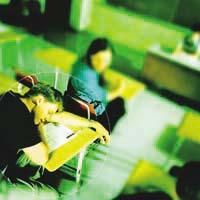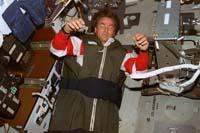Astronauts also want to make siesta
2006/08/27 Galarraga Aiestaran, Ana - Elhuyar Zientzia

Eduard Estevill is a doctor at the Dexeus Institute who investigates sleep disorders and recommends a 20-30 minute nap. He says that on the table the brain needs rest, so if you feel the memory improves, you wake up the ability to be alert and work better in the next hours.
In addition to the Dexeus Institute, numerous studies have been conducted elsewhere to demonstrate the benefits of siesta and its durability. And it is that anyone knows that sometimes the nap does not favor, sometimes it becomes more tired and condolences than before.
According to experts, the duration of the nap has much to do with it: when entering a deep sleep (phase REM), it is difficult to fully awaken. Therefore, a maximum duration of 40 minutes is recommended.
Contribution of astronauts

Sleeping in this situation is not easy. (Photo: ANDÉN)
It seems that now the subject also interests NASA. Astronauts have difficulty sleeping quite a lot. The day and night cycle are not like that of the Earth, they have tasks of great responsibility, they have stress... As a result, they sleep between 0.5 and 2.5 hours less than on Earth.
To avoid tiredness, memory loss, and the bad body or anger that produces a lack of sleep, NASA doctors suspect that siesta can be a proper solution and perform an experiment to find out how the siesta should be to be as favorable as possible.
For this purpose 18 programs have been designed that combine uninterrupted sleep of 4 to 8 hours and naps of 0 to 2.5 hours. They have participated 91 volunteers for ten days. During this time they had to perform several tests or tests to measure memory, the ability to be alert, the response time, etc. In addition, they have controlled some health parameters: baseline temperature, hormone levels in blood and saliva...
Results of interest

Astronauts, having to act on this type of control tables, have to be alert. (Photo: ANDÉN)
With all this, the researchers wanted to measure the effectiveness of the nap, but the results are very clear. For example, they have seen that nap favours working memory, but it does not have much influence on the ability to be alert. It seems that the total number of hours that sleep is what causes the alert. And, of course, both are important to astronauts, both working memory and the ability to be alert.
Another interesting result has been to verify that those who had the night in the program and the cycle of the day in reverse cost them much awakening. Apparently, the bodies of the volunteers considered the periods of daytime sleep and night naps as continuous sleep. Therefore, when they woke up from the nap, it was difficult for them to open their eyes.
Now, with all the data collected in the research, NASA wants to make a mathematical model. With this model they want to know what is the most effective nap depending on the work. In addition to astronauts, this model would be of interest to firefighters, doctors, nurses, drivers and anyone who works in shifts. And for you?
Published in 7K.



